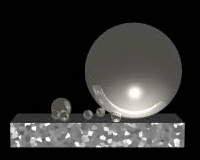The World's Smallest Motor

Scientists recently unveiled the tiniest electric motor ever built. You could stuff hundreds of them into the period at the end of this sentence.
One day a similar engine might power a tiny mechanical doctor that would travel through your body in the ultimate house call.
The motor works by shuffling atoms between two molten metal droplets in a carbon nanotube [watch it run].
One droplet is even smaller than the other. When a small electric current is applied to the droplets, atoms slowly eek off the larger droplet and join the smaller one. The small droplet grows - but never gets as big as the other droplet - and eventually bumps into the large droplet. As they touch, the large droplet rapidly sops up the atoms it had previously sloughed off. This quick shift in energy produces a power stroke.
The technique exploits the fact that surface tension -- the tendency of atoms or molecules to resist separating -- becomes more important at small scales. Surface tension is the same thing that allows some insects to walk on water.
The motor, a surface-tension-driven nanoelectromechanical relaxation oscillator, was built by a team of researchers led by Alex Zettl at the University of California, Berkeley.
Although the amount of energy produced is small -- 20 microwatts -- it is quite impressive in relation to the tiny scale of the motor. The whole setup is less than 200 nanometers on a side, or hundreds of times smaller than the width of a human hair. If it could be scaled up to the size of an automobile engine, it would be 100 million times more powerful than a Toyota Camry's 225 horsepower V6 engine, the researchers say.
Sign up for the Live Science daily newsletter now
Get the world’s most fascinating discoveries delivered straight to your inbox.
In 1988, Berkeley electrical engineering professor Richard Muller and colleagues made the first operating micromotor, which was 100 microns across, or about the thickness of a human hair. In 2003, Zettl's group created the first nanoscale motor. Last year they built a nanoconveyor, which moves tiny particles along like cars in a factory.
A paper discussing the latest invention was published in the March 21 issue of Applied Physics Letters.
Nanotechnology engineers try to mimic nature, building things atom-by-atom. Among other things, nanomotors could be used in optical circuits to redirect light, a process called optical switching. Futurists envision a day when nanomachines, powered by nanomotors, roam inside your body to find disease and repair damaged cells.
"This oscillator is ideal for locomotive applications, since it is so powerful for its size," Chris Regan, a Zettl group researcher, told LiveScience. "For instance, in a nanobot it could be used as the motor that drives crawling, walking, swimming, jumping, or flying."
More immediately, the new motor could be used within two years in existing Micro-Electro-Mechanical Systems (MEMS) technology, Regan said.
MEMS are tiny components made by etching away parts of a silicon wafer or adding tiny layers. As small as a grain of pollen, MEMS are larger than the nanoworld. They are employed in such things as microaccelerometers, the devices that activate automotive airbags. Optical MEMS are used in many home theater systems.
Regan said the shift to NEMS, the nano-equivalent of MEMS, "will take longer."
Related News
- Self-Assembling Nanomachines
- A Step Toward Single-Molecule Computers
- Tiny Paddle Built to Ply Your Body
Varoom!

Robert is an independent health and science journalist and writer based in Phoenix, Arizona. He is a former editor-in-chief of Live Science with over 20 years of experience as a reporter and editor. He has worked on websites such as Space.com and Tom's Guide, and is a contributor on Medium, covering how we age and how to optimize the mind and body through time. He has a journalism degree from Humboldt State University in California.










